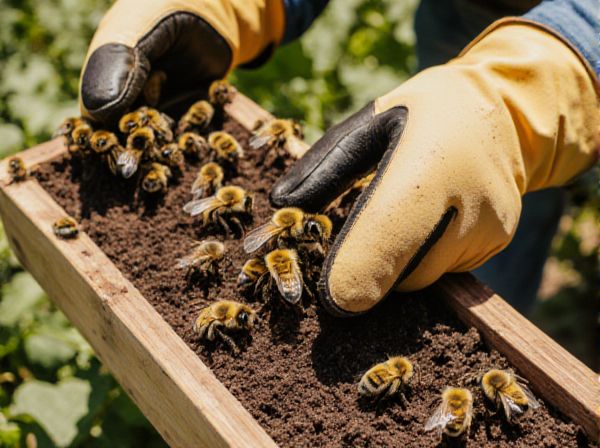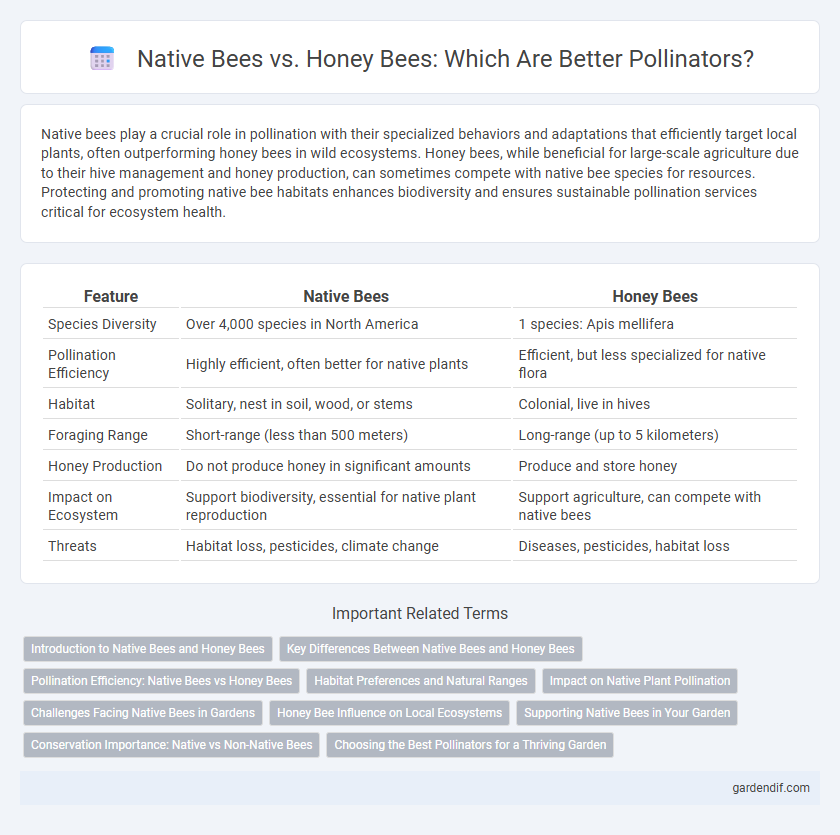
Native bees vs Honey bees Illustration
Native bees play a crucial role in pollination with their specialized behaviors and adaptations that efficiently target local plants, often outperforming honey bees in wild ecosystems. Honey bees, while beneficial for large-scale agriculture due to their hive management and honey production, can sometimes compete with native bee species for resources. Protecting and promoting native bee habitats enhances biodiversity and ensures sustainable pollination services critical for ecosystem health.
Table of Comparison
| Feature | Native Bees | Honey Bees |
|---|---|---|
| Species Diversity | Over 4,000 species in North America | 1 species: Apis mellifera |
| Pollination Efficiency | Highly efficient, often better for native plants | Efficient, but less specialized for native flora |
| Habitat | Solitary, nest in soil, wood, or stems | Colonial, live in hives |
| Foraging Range | Short-range (less than 500 meters) | Long-range (up to 5 kilometers) |
| Honey Production | Do not produce honey in significant amounts | Produce and store honey |
| Impact on Ecosystem | Support biodiversity, essential for native plant reproduction | Support agriculture, can compete with native bees |
| Threats | Habitat loss, pesticides, climate change | Diseases, pesticides, habitat loss |
Introduction to Native Bees and Honey Bees
Native bees, encompassing over 4,000 species in North America alone, are solitary or social pollinators uniquely adapted to local ecosystems, providing efficient pollination for native plants and crops. Honey bees (Apis mellifera), introduced from Europe, live in large, complex colonies and are managed extensively for commercial honey production and crop pollination services worldwide. Both bee types play vital roles in biodiversity and agriculture but differ significantly in behavior, habitat, and pollination strategies.
Key Differences Between Native Bees and Honey Bees
Native bees exhibit greater biodiversity with over 4,000 species in North America alone, compared to the single species of honey bee, Apis mellifera. Unlike honey bees, which form large, social colonies and produce honey, many native bees are solitary or live in smaller nests and do not produce honey. Native bees are often more efficient pollinators for specific local plants due to their co-evolution with native flora, whereas honey bees provide widespread pollination services across various crops.
Pollination Efficiency: Native Bees vs Honey Bees
Native bees exhibit higher pollination efficiency compared to honey bees due to their specialized foraging behaviors and ability to buzz pollinate, which enhances pollen transfer on specific crops like tomatoes and blueberries. Honey bees, while effective in large colonies for pollination, tend to visit a greater variety of plants less selectively, often resulting in lower pollen deposition per flower. Studies show native bees contribute significantly to crop yield and quality, particularly in ecosystems where diverse floral resources support their populations.
Habitat Preferences and Natural Ranges
Native bees typically thrive in diverse habitats ranging from forests to grasslands, favoring nesting sites such as bare soil, dead wood, and plant stems within their natural ranges across North America, Europe, and Asia. Honey bees, originally native to Eurasia and imported globally, prefer more managed environments with access to abundant flowering plants and established hives, often adapting to agricultural landscapes and urban areas. These distinct habitat preferences influence their roles in pollination ecosystems, with native bees supporting local plant biodiversity and honey bees excelling in crop pollination over larger areas.
Impact on Native Plant Pollination
Native bees play a crucial role in pollinating native plants, as their foraging behavior and morphology are often specialized for local floral species. Honey bees, while efficient in crop pollination, can dominate floral resources and reduce pollination opportunities for native bees, potentially disrupting native plant reproduction. The decline in native bee populations due to competition with honey bees may lead to decreased pollination of native plants, threatening biodiversity and ecosystem stability.
Challenges Facing Native Bees in Gardens
Native bees face significant challenges in gardens due to habitat loss, pesticide exposure, and competition from invasive honey bees. Unlike honey bees, native bees require specific nesting sites and diverse floral resources, which are often limited in urban and suburban settings. Conservation efforts must prioritize creating pollinator-friendly habitats and reducing chemical use to support native bee populations effectively.
Honey Bee Influence on Local Ecosystems
Honey bees significantly influence local ecosystems by competing with native bees for floral resources, often leading to reduced native bee populations. Their extensive foraging can alter plant-pollinator dynamics, potentially disrupting the reproductive success of native plants adapted to indigenous pollinators. Management practices must balance honey bee honey production benefits with the conservation of native bee biodiversity to maintain ecosystem stability.
Supporting Native Bees in Your Garden
Native bees provide essential pollination services that nurture local biodiversity and enhance ecosystem stability due to their adaptation to regional flora. Supporting native bees in your garden involves planting diverse, native flowering plants that bloom throughout the growing season, ensuring continuous food sources and nesting habitats. Avoiding pesticides and providing bare soil or wood nesting sites further promotes native bee population health and productivity.
Conservation Importance: Native vs Non-Native Bees
Native bees play a crucial role in maintaining biodiversity and supporting ecosystem health through specialized pollination of native plants, often outperforming non-native honey bees in local environments. Conservation efforts prioritize native bee habitats to preserve these unique pollination services, which contribute to agricultural productivity and natural plant reproduction. Honey bees, despite their commercial value, can compete with native species for resources and sometimes spread diseases, underscoring the importance of protecting native bee populations to ensure ecological balance.
Choosing the Best Pollinators for a Thriving Garden
Native bees contribute significantly to pollination with their specialized behaviors and diverse species adapted to local flora, enhancing garden biodiversity. Honey bees, known for their large colonies and efficiency in commercial pollination, excel in crop pollination but may compete with native species for resources. Selecting native bees for a thriving garden supports ecosystem balance and improves pollination success by catering to specific plant needs and reducing environmental impact.
Native bees vs Honey bees Infographic

 gardendif.com
gardendif.com